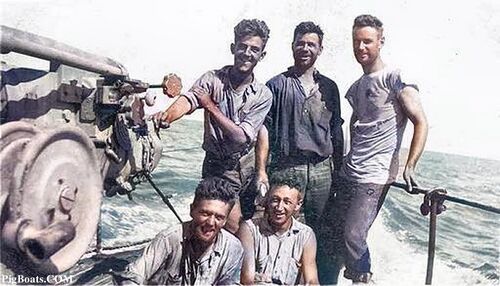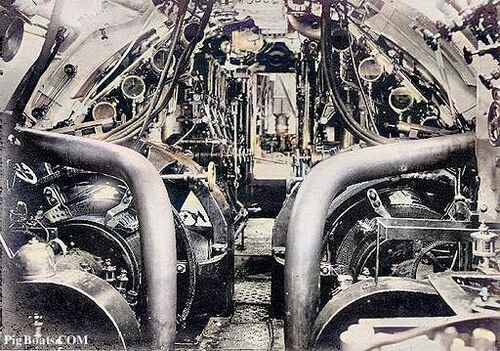What Is A PigBoat
What is a Pigboat?
But, where did the term come from and what did it mean to be a Pigboat sailor? Our earliest subs were built without periscopes. In order to see where they were going, they had to frequently pop to the surface so that the captain could see through small deadlight windows built into the access trunk that stuck up above the deck. After a brief check of his bearings, the captain would take the sub back down and continue on their way. Legend has it that amused surface ship sailors (who thought of the early subs as nothing more than toys) thought this repeated surfacing and diving looked very much like the action of a swimming porpoise. Old time sailors referred to porpoises as “Sea-pigs”.
The early subs were tiny when compared to their cruiser and battleship brethren. Because of their limited range, for long voyages they were hauled out of the water and carried on the deck of larger ships. Any small craft that could be carried on a larger ship was called a “boat”. The combination of these terms led them to be called “Pigboats”.

It became an even more appropriate title when the conditions inside the boats were considered. There was little or no fresh water and the sanitary facilities consisted of an open bucket. Ventilation was poor at best and the air was permeated with a combination of gasoline or diesel fumes, ozone, smoke from frequent electrical shorts, human sweat and sea spray. Combine that with stifling heat and humidity and you can imagine what our first submariners must have looked and smelled like when they returned from a run at sea. Until the late 1920’s, there was also no viable method for escaping from a disabled sub. If the boat suffered even a minor accident, the usual outcome was death for the entire crew.
How did these men cope with these arduous conditions? Frequent and intense swearing (in and of itself an unheralded stress reliever), biting sarcasm, bawdy humor, the spinning of barely believable and outlandishly humorous sea stories, and locker room style practical jokes all served as a relief valve venting the frustrations and stresses they faced. When they returned from sea, the Pigboat sailors lived life as if there was no tomorrow, their drinking and partying escapades becoming the stuff of legends. It was a reaction to being locked up in a steel tube deep under the sea: you were restless and eager to move around in the open air again and exhilarated that you had made it back alive.
It is common that when a group of diverse people are thrown together under perilous and difficult conditions a bond of sorts will develop between them; a unique type of fraternity born out of a shared dangerous experience, stronger than any brotherhood. Due to the boats’ small size and unique nature of operation every man aboard also had to know the job of the all the others. The rigorous and vital process of learning every system, every valve, lever, and gauge became a test of not only your mental acuity, but of your character as well. If you passed the test, you were awarded the highly coveted “Dolphins” insignia and you became a real submariner. The friendship that developed between you and your shipmates was like no other in the Navy. Your buddy may have been rude, crude, and socially unacceptable and you wouldn’t trust him near your sister, but by god you would go to the end of the earth for him. You were immensely proud of your boat and your shipmates and you literally wore this on your sleeve in the form of your embroidered Dolphins.

What else made men want to be Pigboat sailors? Contrary to popular belief, our first submarines were by no means primitive. When taken in the context of the times, they were vessels of incredible ingenuity and sophistication which pushed the existing technological envelope to its limits. It is apt to compare them to the early manned spacecraft of the great Space Race; they were just as advanced a concept and because of that, just as dangerous to operate. Like the spacecraft of the 1960s Project Mercury they represented a challenge: did you have the manly, devil-may-care machismo that it took to push the envelope and make it look easy? Technical competency was an absolute must, and it went hand-in-hand with solid professionalism. This was a potent siren song for men looking for a challenge.

Forward thinkers in the early 1900’s also understood that submarines represented the cusp of a revolution in naval warfare; a paradigm shift in strategy and tactics. Submarines were a virtually undetectable warship that fired a deadly weapon that there was little defense against. This made the battleship sailors who dominated the Navy at that time very nervous, and it drew professional sailors to volunteer for this pathfinding service.
It took a while, but eventually the surface sailors began to see submariners differently. Amongst themselves, they may have looked down their noses at their smelly and socially obnoxious brethren, but deep inside they respected their technical know-how and their fearlessness in the face of danger. When they said, “Look, here comes a Pigboat!” their voices dripped disdain, but if you listened close enough you would pick up the hidden admiration... and the respect.
Page created by:
Ric Hedman & David Johnston
1999 - 2023 - PigBoats.COM©
Mountlake Terrace, WA, Norfolk, VA
webmaster@pigboats.com
